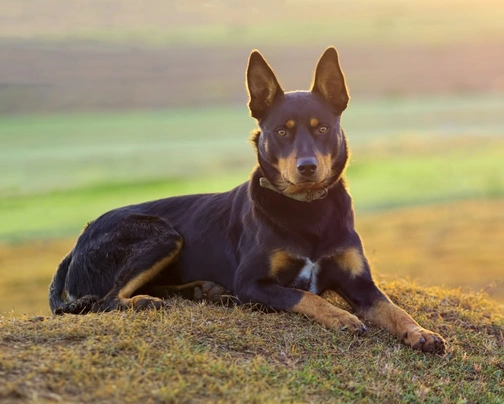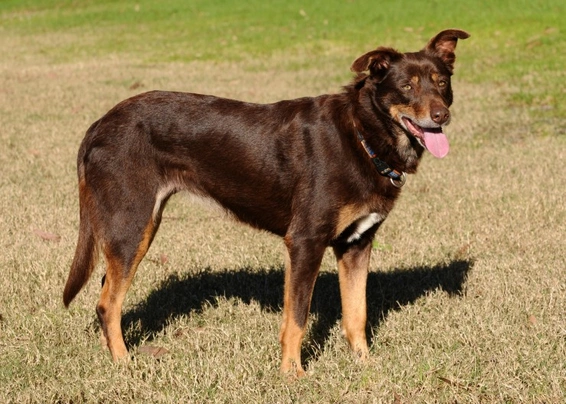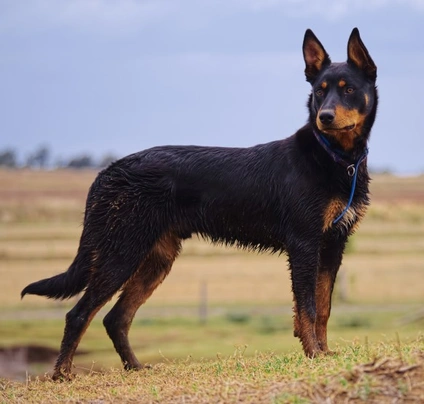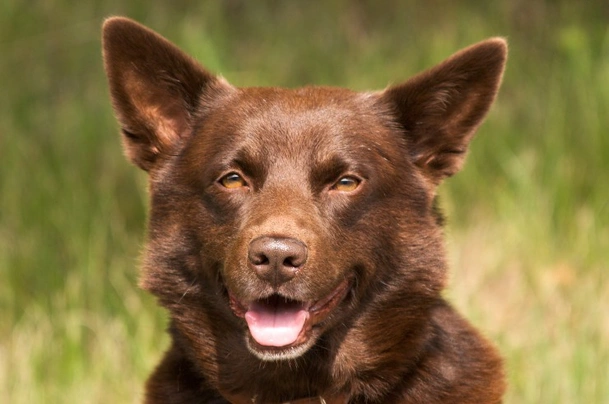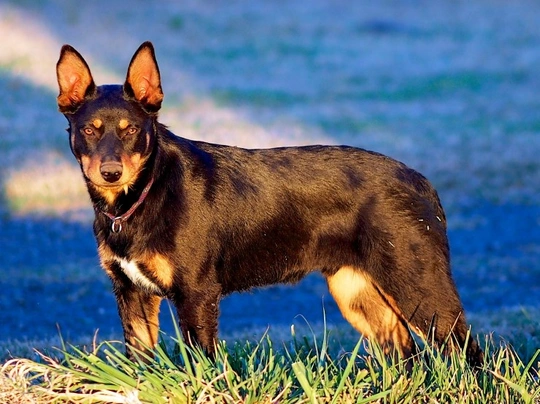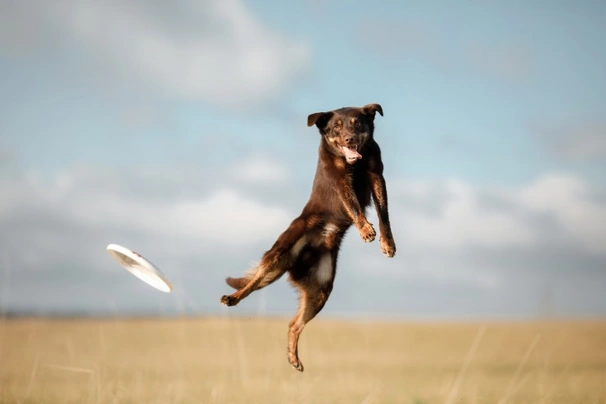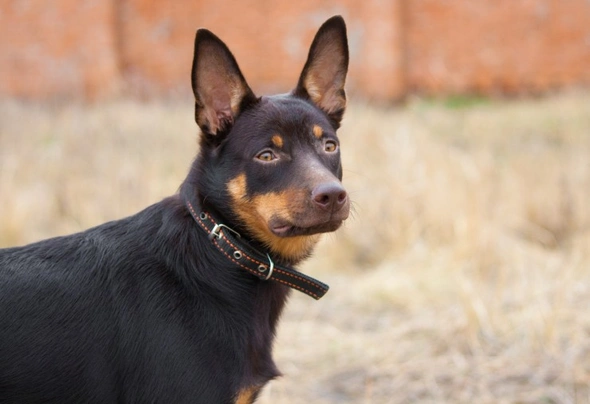Australian Kelpie
Pros
Cons
Introduction of the Australian Kelpie
The Australian Kelpie is a medium sized dog that boasts having an athletic build. They were bred as working dogs and even in a home environment they need to be kept busy to prevent boredom from setting in. Kelpies are also known to be highly intelligent and can be taught to do many things which they love to do.
Although the breed is quite rarely seen outside of Australia where they are highly prized over recent years the Australian Kelpie is fast gaining a fanbase other parts of the world including the UK thanks to their charming looks quick-witted loyal natures and the fact they make such wonderful family pets and companions. With this said the Australian Kelpie is not the best choice for first time dog owners because they need to be socialised handled and trained by people who are familiar with their specific exercise needs.
History of the Australian Kelpie
At one time the origin of the Australian Kelpie was not very clear but these days it is well documented. The breed came about by crossing 3 pairs of working Collies that were taken over to Australia by landowners. The first female to be bred was a dog called Kelpie and she was owned by a man called J. D. Gleeson. She was the prodigy of black and tan working Collies that were bred on Worrock Station. Gleeson also acquired a black dog called Moss a dog that was bred from Collies that were imported to Australia from Scotland. He crossed Kelpie with Moss a mating that produced outstanding puppies which went on to develop one of the best Kelpie lines.
At the turn of the 20th Century many Kelpie-type dogs were to appear on the scene in Australia whether they were "true" Kelpies or not. With this said a true Australian Kelpie is the result of selective breeding using black and tan as well as all black working Collies which had very little white in their coats. At the time Border Collies were known as "black and white rough-coated Working Collies". Today a lot of Kelpies we see today can trace their ancestry to dogs that were imported to Australia during the 1870's.
These Kelpies were bred to be true working dogs and their task was to herd large flocks. Not only did dogs need to be smart and quick witted but they also needed to be tough enough to handle challenging situations and conditions. On top of this they needed to be able to cover vast distances with relative ease. Kelpies were developed for being all of these things and like other sheepdogs they boast having the "Coley" in their ancestry.
Kelpies soon earned themselves the reputation for being reliable tough and intelligent working dogs not only in their native Australia but elsewhere in the world too. However these charming hard-working dogs are rarely seen in a home environment outside of Australia and anyone wishing to share their home with a Kelpie would need to register their interest with breeders and be put on a waiting list because so few puppies are bred in the UK every year. The breed is not yet recognised by The Kennel Club but the United Kennel Club does recognise the Kelpie as a breed and has drawn up a standard with an end goal being to ensure good breeding practices.
Interesting facts about the breed
- Is the Australian Kelpie a vulnerable breed? No although lesser known than the Border Collie in the UK they are fast gaining a large fanbase thanks to their loyal loving and smart natures. However anyone wanting to share a home with a Kelpie would need to register their interest with breeders for the pleasure of doing so
- The coat colours of foundation dogs were black and tan as well as black with very little white in their coats but these days a lot more colours have appeared on the scene
- Australian Kelpies are true "working dogs" but thanks to their kind and reliable natures they are also wonderful family pets
- They have always been highly prized in their native Australia
Appearance of the Australian Kelpie
Height at the withers: Males 39 - 51 cm Females 39 - 51 cm
Average weight: Males 14 - 20 kg Females 14 - 20 kg
The Australian Kelpie is an athletic looking dog and one that gives the appearance of being strong agile yet supple and athletic. They are always on the alert with a keen expression in their eye much like a working Border Collie. Their heads are nicely in proportion with the rest of the body with skulls being a little rounded yet broad between a dog's ears. When seen in profile Kelpies have straight foreheads with a pronounced stop. Muzzles are nicely chiseled and well defined with dogs having tight lips.
Their eyes are brown almond shaped and medium in size being set wide on a dog's face. However dogs with lighter coloured coats may have lighter coloured eyes but all Kelpies have a keen alert expression in their eyes. A Kelpie's nose matches their coat colour and they have a perfect scissor bite where their upper teeth neatly overlap their lower ones. Their ears are set nicely apart on a dog's head and moderate in size being nicely pricked with the outer edge being slightly curved.
Kelpies have moderately long slightly arched necks that merge smoothly into their shoulders. The hair on a dog's neck is slightly longer forming a ruff. They have strong forequarters with nice clean muscular and sloping shoulders. Front legs are strong and well-muscled. They have powerful looking bodies with straight backs deep chests and well sprung ribs. Loins are well muscled and dogs have a nice depth to their flanks**.** Their hindquarters are strong with dogs having long sloping rumps and back legs are powerful with strong upper thighs. Their feet are rounded and strong with deep tight pads and well arched toes. Tails are set to follow the line of a dog's croup which dogs carry low when resting but raised when excited or alert. Their tails are well furnished showing a good amount of brush.
When it comes to their coat the Australian Kelpie boasts having quite a short harsh close lying straight outer coat that's extremely weather resistant and a dense undercoat that provides a lot of protection from the elements. The hair on a dog's legs head ears and feet is short but longer around their neck which forms their ruff. The hair on the back of a dog’s thighs is longer which forms a slight breeching. Tails are nicely furnished forming a brush. The accepted coat colours under the United Kennel Club registration are as follows:
- Black - with or without tan markings
- Blue - ranging from a dark colour to a light one - with or without tan markings
- Red - ranging from chocolate to light red - with or without tan markings
- Tan - ranging from dark to medium
Kelpies can have a white spot strip or blaze on their chests which is acceptable under the UKC standard.
Temperament of the Australian Kelpie
The Australian Kelpie thrives on having something to do and being so intelligent they quickly get bored if left to their own devices for any length of time. As such they are best suited to people who lead active outdoor lives and who would like to have a quick witted canine companion at their side. Kelpies are not the best choice for first time owners nor are they a good choice for people who lead more sedentary lives for this reason. Being so active and intelligent Kelpies are keen and quick to learn new things and excel at many canine sports which includes agility and obedience. They form strong bonds with their owners but can be wary and suspicious around people they don't know especially if they have not been well enough socialised from a young age.
Although they are extremely loyal by nature the Kelpie is strong willed and therefore training them can prove challenging for people who are not familiar with the breed. They need to know who to look to for guidance and who is the alpha dog in a household. They are also prone to nipping and chasing anything that moves thanks to the fact their need to herd anything that moves is so deeply embedded in their psyche. If not gently curbed from a young enough age a Kelpie would chase just about anything and this includes joggers cars bicycles children and other animals whenever they got the chance to. However when well trained and given enough exercise on a daily basis a Kelpie happily settles down in the evening but they remain alert and ready to go even then.
It's really important for these dogs to be well socialised from a young age so they grow up to be confident outgoing mature dogs. Their socialisation must include introducing them to lots of new situations noises people other animals and dogs once they have been fully vaccinated. It's also crucial for their training to start early too and it must be consistent throughout a dog's life. A Kelpie is never happier than when they know their place in the pack and who they can look to for direction and guidance. If they don't know who is the alpha dog in a household they may quickly take on the role of dominant dog which can make them harder to live with and handle.
Are they a good choice for first time owners?
Australian Kelpies are not the best choice for first time dog owners because they need to be socialised handled and trained by people who are familiar with their specific needs when it comes to exercise and mental stimulation.
What about prey drive?
Although Kelpies are very social by nature they do have a high prey drive and loving nothing more than to chase and herd anything that tries to run away which includes the neighbour's cat. The good news is that because they are so eager to please a Kelpie will remain at heel when told to rather than run off after something they have spotted in the distance.
What about playfulness?
Kelpies have a very playful side to their natures and love to entertain and be entertained. They are known to be fun-loving and enjoy playing all sorts of interactive games. They also excel at many canine sports which includes agility flyball and obedience.
What about adaptability?
Although Kelpies are wonderful family pets they are better suited to people who have secure back gardens a dog can safely roam around in whenever possible so they can really let off steam. As such they are not the best choice for people who live in apartments.
What about separation anxiety?
Australian Kelpie form strong ties with their families and dogs are never very happy when they find themselves left on their own for longer periods of time. They are better suited to people who either work from home or in households where one person stays at home when everyone else is out so they are never alone for any length of time which could see a dog suffering from separation anxiety. This can lead to them being destructive around the home which is a dog's way of relieving any stress they are feeling and a way to keep themselves entertained. They are also known to bark incessantly when they are left to their own devices for extended periods of time.
What about excessive barking?
Some Kelpies like the sound of their own voices a little too much which is something that needs to be gently nipped in the bud when a dog is still young being careful not to frighten them bearing in mind that they are known to be sensitive by nature. Others will only bark when there are strangers about or when something they don't like is going on in their surroundings.
Do Australian Kelpies like water?
Most Kelpies love swimming and will take to the water whenever they can more especially when the weather is hot. However if anyone who owns a dog that does not like water should never force them to go in because it would just end up scaring them. With this said care should always be taken when walking a Kelpie off the lead anywhere near more dangerous watercourses just in case a dog decides to leap in and then needs rescuing because they cannot get out of the water on their own.
Are Australian Kelpies good watchdogs?
Kelpies are not natural watchdogs although this is not to say a dog would not be quick off the mark to let an owner know when there are strangers about although they would rarely do this aggressively preferring to keep their distance and bark.
Intelligence / Trainability of the Australian Kelpie
The Australian Kelpie is an extremely smart dog and a fast learner. The downside to this is they are just as quick to pick up bad habits as they are the good. As such their training must begin early and it must be consistent and always fair throughout a dog’s life so they understand what's expected of them. Kelpies are never happier than when they are given something to do which is why they are so amenable to learning new things and if left to their own devices for too long boredom sets in which can lead to dogs becoming unruly and destructive around the home.
They excel at many canine sports which includes activities like flyball agility and obedience because they thrive on the attention they are given during their training and the one-to-one contact with handlers when taking part in an event. The key to successfully training a Kelpie is to make things as interesting as possible and to avoid too much repetition. It's also a good idea to keep training sessions short which helps dogs stay more focused on what it’s being asked of them bearing in mind that the more intelligent a dog is the faster they get bored and as previously mentioned Kelpies are extremely intelligent and boast having an extremely low boredom threshold.
They do not answer well to harsh correction or any sort of heavy handed training methods but they do respond extremely well to positive reinforcement which always brings the best out of these intelligent and quick-witted dogs especially when there are high value rewards involved.
Kelpie puppies like all puppies are incredibly cute and it is all too easy to spoil them when they first arrive in a new home. However once a puppy is settled owners should lay down ground rules and boundaries because Kelpies are extremely smart and quick to learn new things which includes the good with the bad. All puppies like to know what is expected of them and what is acceptable behaviour and what is not. Laying down the "rules" also helps establish a pecking order and who is the alpha dog in a household. The first commands a puppy should be taught are as follows:
- Come
- Sit
- Stay
- Heel
- Quiet
- Leave it
- Down
- Bed
Children and other
Kelpies are known to be good with older children who know how to behave around dogs. However any interaction between toddlers and a Kelpie should always be well supervised by an adult to make sure playtime does not get too boisterous which could end up with someone being knocked over and hurt especially as Kelpies are known to nip ankles when they want a child to move along which is a trait that’s deeply embedded in their natures.
When dogs have been well socialised from a young enough age they generally get on well with other dogs they meet. However care must be taken when they are around any smaller animals and pets which includes cats because of their high herding instincts. As such any contact is best avoided.
Health of the Australian Kelpie
The average life expectancy of an Australian Kelpie is between 12 and 15 years when properly cared for and fed an appropriate good quality diet to suit their ages.
The Kelpie is known to suffer from a few hereditary health issues which are worth knowing about if you are planning share your home with one of these extraordinary dogs. The conditions that seem to affect the breed the most include the following:
- Hip dysplasia - dogs should be hip scored
- Collie eye anomaly (CEA/CH) - dogs should be eye tested
- Progressive retinal atrophy (PRA) - dogs should be eye tested
- Cerebellar abiotrophy (CA ataxia)
- Luxating patella
What about vaccinations?
Kelpie puppies would have been given their initial vaccinations before being sold but it is up to their new owners to make sure they have their follow-up shots in a timely manner with the vaccination schedule for puppies being as follows:
- 10 -12 weeks old bearing in mind that a puppy would not have full protection straight away but would be fully protected 2 weeks after they have had their second vaccination
There has been a lot of discussion about the need for dogs to have boosters. As such it's best to talk to a vet before making a final decision on whether a dog should continue to have annual vaccinations which are known as boosters.
What about spaying and neutering?
A lot of vets these days recommend waiting until dogs are slightly older before spaying and neutering them which means they are more mature before undergoing the procedures. As such they advise neutering males and spaying females when they are between the ages of 6 to 9 months old and sometimes even when a dog is 12 months old.
Other vets recommend spaying and neutering dogs when they are 6 months old but never any earlier unless for medical reasons. With this said many breeds are different and it is always advisable to discuss things with a vet and then follow their advice on when a dog should be spayed or neutered.
What about obesity problems?
Some Kelpies gain weight after they have been spayed or neutered and it's important to keep an eye on a dog's waistline just in case they do. If a dog starts to put on weight it's important to adjust their daily calorie intake and to up the amount of exercise they are given. Older dogs too are more prone to gaining weight and again it's essential they be fed and exercised accordingly because obesity can shorten a dog's life by several years. The reason being that it puts a lot of extra strain on a dog's internal organs including the heart which could prove fatal.
What about allergies?
Australian Kelpies are not known to be prone to suffering from allergies but if a problem flares up it's important for a dog to see a vet sooner rather than later if one flares up. Allergies can be notoriously hard to clear up and finding the triggers can be challenging. With this said a vet would be able to make a dog with an allergy more comfortable while they try to find out the triggers which could include the following:
- Certain dog foods containing high levels of grains and other cereal-type fillers
- Airborne pollens
- Dust mites
- Environment
- Flea and tick bites
- Chemicals found in everyday household cleaning products
Participating in health schemes
All responsible Australian Kelpie breeders would ensure that their stud dogs are tested for known hereditary and congenital health issues known to affect the breed by using the following schemes:
- Hip scoring for hip dysplasia
- Dogs should be tested for Collie eye anomaly (CEO)
- Dogs should be eye tested for progressive retinal atrophy (PRA)
What about breed specific breeding restrictions?
There are no breed specific breeding restrictions for the Australian Kelpie because they are not recognised by the Kennel Club. However all breeders should follow the advice and recommendations laid out by the Kennel Club to ensure the continued health and well-being of the Australian Kelpie.
What about Assured Breeder Requirements?
The Australian Kelpie is not a Kennel Club registered breed as such there are no Assured Breeder requirements in place.
Caring for the Australian Kelpie
Australian Kelpies need to be groomed on a regular basis to make sure their coats and skin are kept in top condition. They also need to be given regular daily exercise to ensure they remain fit and healthy. On top of this dogs need to be fed good quality food that meets all their nutritional needs throughout their lives.
Caring for an Australian Kelpie puppy
Kelpie puppies are boisterous and full of life which means it's essential for homes and gardens to be puppy-proofed well in advance of their arrival. A responsible breeder would have well socialised their puppies which always leads to more outgoing confident and friendly dogs right from the word go. With this said any puppy is going to feel vulnerable when they leave their mother and littermates which must be considered. The longer a puppy can remain with their mother the better although it should never be for too long either.
It's best to pick a puppy up when people are going to be around for the first week or so which is the time needed for a puppy to settle in. Puppy-proofing the home and garden means putting away any tools and other implements that a boisterous puppy might injure themselves on. Electric wires and cables must be put out of their reach because puppies love chewing on things. Toxic plants should be removed from flowerbeds and the home too.
Puppies need to sleep a lot to grow and develop as they should which means setting up a quiet area that's not too out of the way means they can retreat to it when they want to nap and it's important not to disturb them when they are sleeping. It's also a good idea to keep "playtime" nice and calm inside the house and to have a more active "playtime" outside in the garden which means puppies quickly learn to be less boisterous when they are inside.
The documentation a breeder provides for a puppy must have all the details of their worming date and the product used as well as the information relating to their microchip. It is essential for puppies to be wormed again keeping to a schedule which is as follows:
- Puppies should be wormed at 6 months old
- They need to be wormed again when they are 8 months old
- Puppies should be wormed when they are 10 months old
- They need to be wormed when they are 12 months old
Things you'll need for your puppy
There are certain items that new owners need to already have in the home prior to bringing a new puppy home. It's often a good idea to restrict how much space a puppy plays in more especially when you can't keep an eye on what they get up to bearing in mind that puppies are often quite boisterous which means investing in puppy gates or a large enough playpen that allows a puppy the room to express themselves while keeping them safe too. The items needed are therefore as follows:
- Good quality puppy or baby gates to fit on doors
- A good well-made playpen that's large enough for a puppy to play in so they can really express themselves as puppies like to do
- Lots of well-made toys which must include good quality chews suitable for puppies to gnaw on bearing in mind that a puppy will start teething anything from when they are 3 to 8 months old
- Good quality feed and water bowls which ideally should be ceramic rather than plastic or metal
- A grooming glove
- A slicker brush or soft bristle brush
- Dog specific toothpaste and a toothbrush
- Scissors with rounded ends
- Nail clippers
- Puppy shampoo and conditioner which must be specifically formulated for use on dogs
- A well-made dog collar or harness
- A couple of strong dog leads
- A well-made dog bed that's not too small or too big
- A well-made dog crate for use in the car and in the home that's large enough for a puppy to move around in
- Baby blankets to put in your puppy's crate and in their beds for when they want to nap or go to sleep at night
Keeping the noise down
All puppies are sensitive to noise including Australian Kelpie puppies bearing in mind that like all collie-type breeds they can be ultra-sensitive to loud sounds by nature. It's important to keep the noise levels down when a new puppy arrives in the home. TVs and music should not be played too loud which could end up stressing a small puppy out which could result in them being timid and shy.
Keeping vet appointments
As previously mentioned Kelpie puppies would have been given their first vaccinations by the breeders but they must have their follow up shots which is up to their new owners to organise. The vaccination schedule for puppies is as follows:
- 10 -12 weeks old bearing in mind that a puppy would not have full protection straight away but would only be fully protected 2 weeks after they have had their second vaccination
When it comes to boosters it's best to discuss these with a vet because there is a lot of debate about whether a dog really needs them after a certain time. However if a dog ever needed to go into kennels their vaccinations would need to be fully up to date.
What about older Australian Kelpies when they reach their senior years?
Older Kelpies need lots of special care because as they reach their golden years they are more at risk of developing certain health concerns. Physically a dog's muzzle may start to go grey but there will be other noticeable changes too which includes the following:
- Coats become coarser
- A loss of muscle tone
- Australian Kelpies can either become overweight or underweight
- They have reduced strength and stamina
- Older dogs have difficulty regulating their body temperature
- They often develop arthritis
- Immune systems do not work as efficiently as they once did which means dogs are more susceptible to infections
Older dogs change mentally too which means their response time tends to be slower as such they develop the following:
- They respond less to external stimuli due to impaired vision or hearing
- They tend to be a little pickier about their food
- They have a lower pain threshold
- Become intolerant of any change
- Often an older dog can feel disorientated
Living with an Australian Kelpie in their golden years means taking on a few more responsibilities but these are easily managed and should include taking a look at their diet the amount of exercise they are given how often their dog beds need changing and keeping an eye on the condition of their teeth.
Older Kelpies need to be fed a good quality diet that meets their needs at this stage of their lives all the while keeping a close eye on a dog's weight. A rough feeding guide for older dogs is as follows bearing in mind they should be fed highly digestible food that does not contain any additives:
- Protein content should be anything from 14 – 21%
- Fat content should be less than 10%
- Fibre content should be less than 4%
- Calcium content should be 0.5 – 0.8%
- Phosphorous content should be 0.4 – 0.7%
- Sodium content should be 0.2 – 0.4%
Older Kelpies don't need to be given the same amount of daily exercise as a younger dog but they still need the right amount of physical activity to maintain muscle tone and to prevent a dog from putting on too much weight. All dogs need access to fresh clean water and this is especially true of older dogs when they reach their golden years because they are more at risk of developing kidney disorders.
Grooming of the Australian Kelpie
Australian Kelpies boast having short close lying double coats and as such they are low maintenance on the grooming front. A twice weekly brush all it takes to keep their coats in good condition. However for dogs with such short hair they do tend to shed more than expected. With this said they shed steadily throughout the year only more so during the Spring and then again in the Autumn when they do shed quite heavily and therefore more frequent grooming is usually necessary to stay on top of things and to remove dead and shed hair from a dog's coat.
It's also important to check a dog's ears on a regular basis and to clean them when necessary. If too much wax is allowed to build up it can lead to a painful infection which can be hard to clear up. In short prevention is often easier than cure with ear infections.
Exercise of the Australian Kelpie
The Australian Kelpie is energetic and highly intelligent. They need to be given the right amount of daily exercise and mental stimulation for them to be truly happy well-rounded dogs. They need at least 2 hour's exercise a day with as much off the lead time as possible in a safe environment. If they are not given the right amount of mental stimulation and exercise every day a Kelpie would quickly get bored and could even begin to show some destructive behaviours around the home which is their way of relieving any stress they are feeling and not necessarily because they are being naughty.
A shorter walk in the morning would be fine but a longer more interesting one in the afternoon is a must with as much off the lead time as possible. These dogs also like to be able to roam around a back garden so they can really let off steam. However the fencing must be extremely secure to keep these active high-energy dogs in because if they find a weakness in the fence they would soon escape and could get into all sorts of trouble.
With this said puppies should not be over exercised because their joints and bones are still growing. This includes not letting a dog jump up and down from furniture or going up or down the stairs. Too much pressure placed on their joints and spines at an early age could result in a dog developing serious and painful problems later in their lives.
Feeding of the Australian Kelpie
If you get an Australian Kelpie puppy from a breeder they would give you a feeding schedule and it's important to stick to the same routine feeding the same puppy food to avoid any tummy upsets. You can change a puppy's diet but this needs to be done very gradually always making sure they don't develop any digestive upsets and if they do it's best to put them back on their original diet and to discuss things with the vet before attempting to change it again.
Older dogs are not known to be fussy eaters but this does not mean they can be given a lower quality diet. It's best to feed a mature dog twice a day once in the morning and then again in the evening making sure it's good quality food that meets all their nutritional requirements. It's also important that dogs be given the right amount of exercise so they burn off any excess calories or they might gain too much weight which can lead to all sorts of health issues. Obesity can shorten a dog's life by several years so it's important to keep an eye on their waistline from the word go.
Feeding guide for an Australian Kelpie puppy
Puppies need to be fed a highly nutritious good quality diet for them to develop and grow as they should. As a rough guide a Kelpie puppy can be fed the following amounts every day making sure their meals are evenly spread out throughout the day and it's best to feed them 3 or 4 times a day:
- 2 months old - 173 g to 208 g depending on a puppy's build
- 3 months old - 199 g to 252 g depending on a puppy's build
- 4 months old - 211 g to 298 g depending on a puppy's build
- 5 months old - 214 g to 319 g depending on a puppy's build
- 6 months old - 214 g to 341 g depending on a puppy's build
- 8 months old - 177 g to 305 g depending on a puppy's build
- 12 months old - 219 g to 237 g depending on a puppy's build
Once a puppy is 13 months old they can be fed adult dog food.
Feeding guide for an adult Australian Kelpie
Once fully mature an adult Australian Kelpie must be fed a good quality diet to ensure their continued good health. As a rough guide an adult Kelpie can be fed the following amounts every day:
- Dogs weighing 14 kg can be fed 178g to 234g depending on activity
- Dogs weighing 20 kg can be fed 232g to 305g depending on activity
Australian Kelpie price
If you are looking to buy an Australian Kelpie you would need to register your interest with breeders and agree to being put on a waiting list because very few puppies are bred every year. You would need to pay anything upwards of £300 for a well-bred puppy. The cost of insuring a male 3-year-old Australian Kelpie in northern England would be £21.87 a month for basic cover but for a lifetime policy this would set you back £43.98 a month (quote as of January 2018). When insurance companies calculate a pet's premium they factor in several things which includes where you live in the UK a dog's age and whether they have been neutered or spayed among other things.
When it comes to food costs you need to buy the best quality food whether wet or dry making sure it suits the different stages of a dog’s life. This would set you back between £20 - £30 a month. On top of this you need to factor in veterinary costs if you want to share your home with an Australian Kelpie and this includes their initial vaccinations their annual boosters the cost of neutering or spaying a dog when the time is right and their yearly health checks all of which quickly adds up to over £800 a year.
As a rough guide the average cost to keep and care for an Australian Kelpie would be between £50 to £80 a month depending on the level of insurance cover you opt to buy for your dog but this does not include the initial cost of buying a well-bred health tested Australian Kelpie puppy.
Buying advice
When visiting and buying any puppy or dog there are many important things to consider and questions to ask of the breeder/seller. You can read our generic puppy/dog advice here which includes making sure you see the puppy with its mother and to verify that the dog has been wormed and microchipped.
Over recent years Australian Kelpies have found a large fanbase both in the UK and elsewhere in the world which means that well-bred puppies command a lot of money. As such with Kelpies there is specific advice questions and protocols to follow when buying a puppy which are as follows:
- Beware of online scams and how to avoid them. You may see online and other adverts by scammers showing images of beautiful Australian Kelpiepuppies for sale at very low prices. However the sellers ask buyers for money up front before agreeing to deliver a puppy to a new home. Potential buyers should never buy a puppy unseen and should never pay a deposit or any other money online to a seller. You should always visit the pet at the sellers home to confirm they are genuine and make a note of their address.
- As previously touched upon Australian Kelpies are finding a bit fanbase in the UK. As such there are many amateur breeders/people who breed from a dam far too often so they can make a quick profit without caring for the welfare of the puppies their dam or the breed in general. Although the breed is not Kennel Club recognised all breeders should follow KC advice and recommendations when it comes to breeding practices which state that a dam can only produce 4 litters and she must be between a certain age to do so. Anyone wishing to buy a Kelpie puppy should think very carefully about who they purchase their puppy from and should always ask to see the relevant paperwork pertaining to a puppy's lineage their vaccinations and their microchipping.
- Prospective owners should be very careful when considering buying an Australian Kelpie puppy and ask breeders to see their lineage to make sure they are “true” Kelpies and not the result of outcrossing an Australian Kelpie to another collie-type breed .

Australian Kelpie pups WKC registered
£795
Pure bred Kelpie puppies
£1,000
